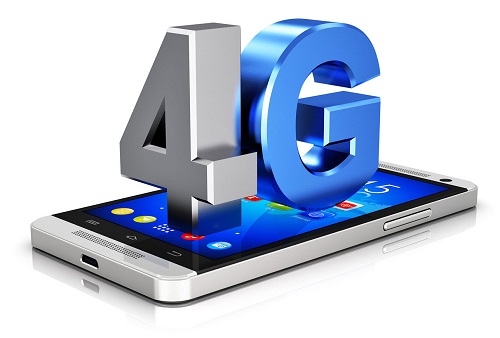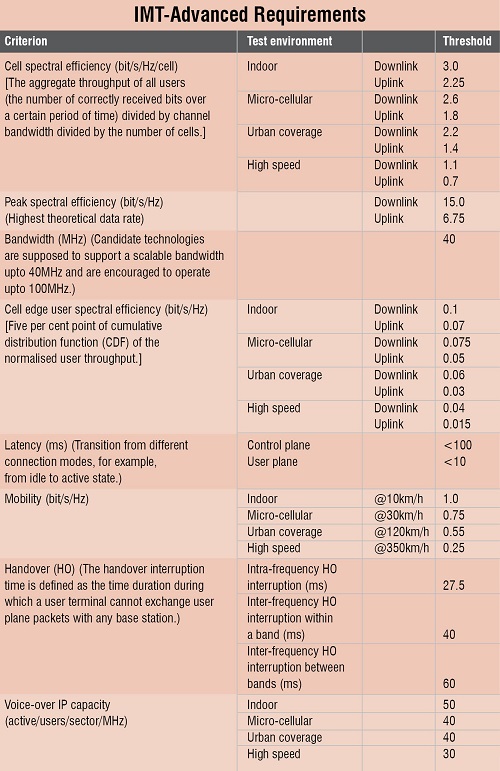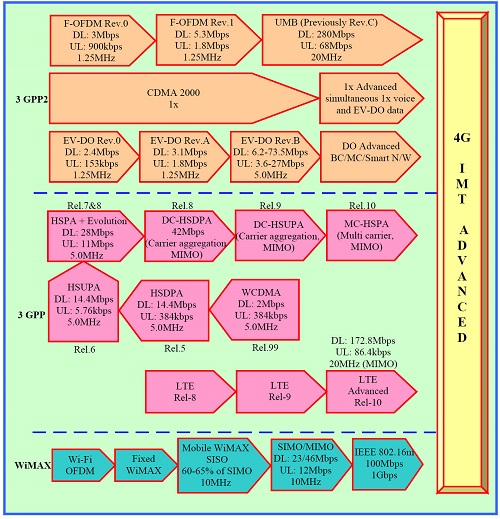With the objective to fulfil the 4G criteria of 1Gbps for stationary reception and 100Mbps for mobile reception, many wireless technologies are rapidly progressing to meet and surpass 4G requirements.
4G is the fourth generation of mobile wireless standards—a successor to the 3G and 2G families of standards—and is expected to provide a comprehensive and secure all-IP based mobile broadband solution to laptop/computer wireless modems, smartphones and other mobile devices. With the help of such promising next-generation technology, facilities such as ultra-broadband Internet access, IP telephony, gaming services, high-resolution streamed multimedia [multimedia messaging service, video chat, video conferencing, mobile TV and HDTV (high-definition TV)] may be provided to users. The system will allow global roaming, higher rate of data transfer with much higher and tight security and safety features, all at a lower cost.
In 2009, the International Telecommunication Union—Radiocommunication (ITU-R) group specified the international mobile telecommunications-Advanced (IMT-Advanced) requirement s for 4G standards, setting peak speed requirements for 4G services at 100Mbps for high-mobility communication and 1Gbps for low-mobility or fixed communication. As the most advanced technologies currently defined for global wireless mobile broadband communications, IMT-Advanced is considered as 4G, although it is recognised that this term may also be applied to the forerunners and other evolved 3G technologies providing a substantial level of improvement in performance and capabilities with respect to initial third-generation systems.
s for 4G standards, setting peak speed requirements for 4G services at 100Mbps for high-mobility communication and 1Gbps for low-mobility or fixed communication. As the most advanced technologies currently defined for global wireless mobile broadband communications, IMT-Advanced is considered as 4G, although it is recognised that this term may also be applied to the forerunners and other evolved 3G technologies providing a substantial level of improvement in performance and capabilities with respect to initial third-generation systems.
IMT-Advanced or 4G systems are mobile systems that include new capabilities of IMT that go beyond those of IMT-2000. Such systems provide access to a wide range of telecommunication services including advanced mobile services, supported by mobile and fixed networks, which are increasingly packet based. IMT-Advanced systems support low to high mobility applications and a wide range of data rates in accordance with user and service demands in multiple user environments. Moreover, IMT‑Advanced has capabilities for high-quality multimedia applications within a wide range of services and platforms, providing a significant improvement in performance and quality of service. These features enable IMT-Advanced to address evolving user needs.
Scanning the mobile generations
There are no specific measures to consider the years of generations. Rather, generations are measured on the basis of significant stages or considerable innovations in standards and applications. Significant stages in the evolution of mobile radio systems are referred to in terms of generations: 0th generation or 0G, first generation or 1G, second generation or 2G, third generation or 3G, and fourth generation or 4G. Reviewing previous wireless generations will help put 4G in context.

0G systems preceded modern mobile telephony and are referred to as mobile radio telephone systems. Mobile radio service originated with Bell Systems in 1946. Technologies used in pre-mobile systems included push-to-talk (PTT or manual), mobile telephone system (MTS), mobile telephony system A/B/C/D (MTA/B/C/D), offentlig landmobil telefoni (OLT), improved mobile telephone service (IMTS) and advanced mobile telephone system (AMTS).
The 1G of mobile generation came in 1980s, offering for the first time a relatively affordable mobile wireless telephony service. 1G was characterised by a multiplicity of incompatible regional analogue standards such as analogue advanced mobile phone system (AMPS)—North American standard in mobile band (800MHz), total access communications system (TACS)—the UK-originated standard based on AMPS in 900MHz band, Nordic mobile telephony system (NMT)—Scandinavian standard in 450MHz and 900MHz bands, C-450—German standard in 450MHz band and Japanese total access communications system (JTACS)—Japanese standard in 900MHz band. These incompatible analogue standards kept the market fragmented, expensive and without national roaming facility.
In early 1990s, global system for mobile (GSM) communication, the first of the digital 2G, arrived to provide telephony plus text messaging and limited circuit-switched data services. For GSM, everything lined up—technology, demand, supply, pricing, value and delivery costs. The result remains an enormous international industry that in 15 years grew from nothing to being owned by more than half the people on the planet, revolutionising the way the world communicates.
2.5G, which stands for second and a half generation, is a mobile wireless technology developed in between its predecessor, 2G, and its successor, 3G. 2.5G is used to describe 2G systems that have implemented a packet-switched domain in addition to circuit-switched domain. Such a packet-switched base service is general packet radio service (GPRS) that can provide moderate-speed data rates from 56kbps to 114kbps using time division multiple access (TDMA) channels in the GSM system.
Another extension of GSM is 2.75G—enhanced data rates for GSM evolution (EDGE) or IMT-SC (single carrier) that is able to support both circuit-switched and packet-switched networks. EDGE can carry a bandwidth up to 236.8kbps for four timeslots (theoretical maximum is 473.6kbps for eight timeslots) in packet mode. The other main 2G system is code division multiple access (CDMA), which offers services similar to GSM but in different geographies.
Following the phenomenal and unexpected success of 2G, there was heightened anticipation of what 3G would bring, but 3G’s contribution to date is a very mixed bag. On a technical level, 3G met the increased single-user data rates mandated by IMT-2000 requirements, but the uptake of much-hyped 3G services such as video telephony has been poor. This is why 3G subscriptions are just over seven per cent of 2G subscriptions, and many of these are primarily using telephony and basic messaging rather than 3G-specific data services.
Real uptake of data services did not start until the introduction of the so-called 3.5G packet based data services, like high-speed downlink packet access (HSDPA) on universal mobile telecommunication system (UMTS) and evolution data optimised (1xEV-DO) on CDMA2000. Dedicated data-only devices with flat-rate tariffs (for example, USB dongles used with laptops) are showing strong growth in some markets with good performance, at least for early adopters. 3G’s impact is currently much less significant than the step from 1G to 2G.
Pre-4G technologies, such as mobile worldwide inter-operability for microwave access (WiMAX) and first-release 3G long-term evolution (LTE), have been available in the market since 2006 and 2009, respectively. Early WiMAX versions and first-release LTE captured the attention of wireless service provider giants around the world, but their market penetration is yet to be seen and their fate is not very clear.
4G refers to the fourth generation of mobile wireless standards. It is a successor to 3G and 2G families of standards. The expectation for 4G technology is basically the high-quality audio/video streaming over end-to-end Internet protocol.
IMT-Advanced requirements
ITU-R for IMT-Advanced has set a specific level of minimum performance that each proposed technology needs to achieve to fulfill the objectives of IMT-Advanced. These requirements are demonstrated, at a glance, in Table I.
IMT-Advanced (4G) candidate technologies
Based on the thresholds set by ITU-R for IMT-Advanced, none of the wireless technologies at present, including LTE, high-speed packet access + (HSPA+) and WiMAX can be considered as 4G technology.
For HSPA+, main limitations are spectral efficiency, bandwidth and latency. On the latency front, HSPA+ cuts the user plane latency dramatically but it is still measured to be around 30ms to 40ms (round-trip delay) for best networks (refer Table I for comparison).
For LTE, being a much newer revolutionary technology, technology designers tried to improve the spectral efficiency by heavy use of multiple input multiple output (MIMO). LTE networks have been deployed with 2×2 MIMO from the start. This allowed the spectral efficiency to be boosted up; reaching peak spectral efficiency of 7.3bit/s/Hz (10MHz bandwidth), with the cell spectral efficiency level of 1.8bit/s/Hz (10MHz bandwidth). Even though LTE was defined for channelisation of 20MHz, 700MHz band, it is not large enough for such large bands to be assigned to a single operator. LTE user plane delay looks comparable to HSPA+ network.
WiMAX is fairly comparable to LTE in terms of spectral efficiency and delay capabilities since these share the same multiple access scheme and use similar modulation and coding scheme. Similar to LTE, WiMAX also uses 2×2 MIMO. WiMAX latency profile is similar to LTE due to flatter network compared to HSPA+, but round trip delays ranging between 100ms and 140ms put WiMAX quite far from IMT-Advanced targets.
Even though none of these technologies are fulfilling the IMT-Advanced criterion, each one has an evolution path to get there. An evolution path to 4G is depicted in Fig. 1.
HSPA+ is being expanded to allow 40MHz channelisation with 4×4 MIMO capabilities that allows it to achieve 16.8bit/s/Hz peak spectral efficiency. Details about how to achieve other targets are all part of release 11, which is expected to be completed very soon.
LTE is closer to 4G thresholds compared to HSPA+ and was formally submitted by the 3GPP organisation. Primarily, LTE was designed to incorporate MIMO from the start. If 4×4 MIMO is implemented in the terminal form factor to have an LTE-category five devices, then using LTE-Advanced that allows 40MHz to 100MHz channelisation will bring true 4G capabilities.

LTE-Advanced is part of 3GPP release 10 and is essentially an enhancement to the existing LTE network. This upgrade path makes it more cost-effective for vendors to offer LTE and then upgrade to LTE-Advanced. LTE-Advanced (release 10) has been formally submitted by 3GPP in fall 2009 to achieve high data rates of 1Gbps peak download and 500Mbps peak upload, and it is expected to be released soon.
On WiMAX front, IEEE 802.16m or wireless MAN-Advanced evolution of 802.16e (mobile WiMAX) is under development, with the objective to fulfil the IMT-Advanced criteria of 1Gbps for stationary reception and 100Mbps for mobile reception.
Some other technologies like 1x-Advanced, DO-Advanced and ultra mobile broadband (UMB) are also rapidly progressing to meet and surpass the IMT-Advanced requirements. Following a detailed evaluation against stringent technical and operational criteria, ITU has determined that LTE-Advanced and IEEE 802.16m/wireless MAN-Advanced should be accorded the official designation of IMT-Advanced, which is considered as 4G.
In a nutshell
The wonder technology 4G is expected to cover the data-rate deficiency in previous generations. It is also aimed to achieve quality of services including voice chat, video calls, MMS, HDTV and voice-over Internet protocol (VoIP). This technology aims to provide 100Mbps data rate for moving users and 1Gbps for stationary users so that they can enjoy uninterrupted connectivity with high speed anywhere they go.
Flawless connectivity and international roaming across innumerable networks of the world is its next target. It is an all-IP-switched network and several working groups propose that it should offer an open Internet protocol. The technology components being considered for 4G include carrier aggregation, advanced access schemes, enhanced multiple antenna transmission, relaying and repeater solutions, among others. In addition to these solutions to enhance coverage and cell edge data rates, an evolution of inter-cell interference coordination in the form of coordinated multi-point transmission/reception is yet another technology to enhance the 4G network performance.
4G candidate technologies are LTE-Advanced, wireless MAN-Advanced or mobile WiMAX 802.16m, 1x-Advanced, UMB, DO Advanced and MC-HSPA. Recently, ITU has determined that LTE-Advanced and wireless MAN-Advanced should be accorded the official designation of 4G. Capabilities of IMT-Advanced/4G systems are being continuously enhanced in line with user trends and technology developments.







